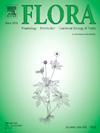罗马尼亚贝母种形态解剖学比较研究及其分类学意义
IF 1.8
4区 生物学
Q3 ECOLOGY
引用次数: 0
摘要
本研究调查了罗马尼亚本地贝母种:中亲贝母montana Hoppe ex W.D.J. Koch、中亲湿贝母meleagris L.和meleagroides Schult贝母。, Schult。费尔。(halo-hygrophilous)。蒙大拿贝母和meleagris贝母在罗马尼亚受到保护,而meleagides贝母是新记录的国家植物区系。这些分类群的野外鉴定依赖于生殖期可见的形态特征。该研究检查了营养器官(根、球茎、茎和叶),以提供对物种形态解剖学的详细了解,并有助于花期以外的分类鉴定。鉴于它们不同的生态需求,特别关注与土壤湿度条件有关的结构变化。形态学测量由光学显微镜下检查的横切面和叶面解剖分析补充。各类群间形态差异不大,解剖分析显示各营养器官的组织学特征明显。主要特征包括根皮质和球茎储存薄壁中是否存在有气孔;茎髓实质中有气孔结构的变异;茎实质的尺寸变化;导电束的数值和尺寸差异;在椎板中存在或不存在囊鞘;以及层截面轮廓的差异。与湿度偏好有关的解剖特征,特别是有气孔构造的发生,被证明是区分生殖期以外物种的最重要的信息。这些特征构成了二分识别密钥的基础,设计用于光学显微镜下使用。该密钥能够在营养阶段或从营养碎片中可靠地识别贝母分类群。本文章由计算机程序翻译,如有差异,请以英文原文为准。
Comparative morpho-anatomical study of the native Fritillaria species from Romania and its taxonomic significance
This study investigated the native Fritillaria species of Romania, Fritillaria montana Hoppe ex W.D.J. Koch (mesophilous), Fritillaria meleagris L. (meso‑hygrophilous), and Fritillaria meleagroides Schult. & Schult. fil. (halo-hygrophilous). Fritillaria montana and Fritillaria meleagris are protected in Romania, whereas Fritillaria meleagroides is newly recorded in the national flora. Field identification of these taxa relied on morphological traits visible during the reproductive period.
The study examines the vegetative organs (roots, bulbs, stems, and leaves) to provide a detailed understanding of species morpho-anatomy and to aid taxonomic identification outside the flowering phase. Given their differing ecological requirements, particular focus was on structural variation related to soil moisture conditions. Morphological measurements were complemented by anatomical analyses of cross-sections and paradermal sections (leaf) examined under optical microscopy.
Morphological differences among taxa were minor, whereas anatomical analyses revealed distinct histological features in all vegetative organs. Key traits include the presence or absence of aeriferous cavities in the root cortex and bulb storage parenchyma; variation in aeriferous formations in the stem medullary parenchyma; dimensional variation in stem parenchyma; numerical and dimensional differences in conductive bundles; presence or absence of perifascicular sheaths in the lamina; and differences in lamina cross-section outline.
Anatomical traits linked to moisture preference, particularly the occurrence of aeriferous formations, proved most informative for distinguishing species outside the reproductive period. These features formed the basis of a dichotomous identification key, designed for use under optical microscopy. The key enables reliable identification of Fritillaria taxa during the vegetative stage or from vegetative fragments.
求助全文
通过发布文献求助,成功后即可免费获取论文全文。
去求助
来源期刊

Flora
生物-植物科学
CiteScore
3.30
自引率
10.50%
发文量
130
审稿时长
54 days
期刊介绍:
FLORA publishes original contributions and review articles on plant structure (morphology and anatomy), plant distribution (incl. phylogeography) and plant functional ecology (ecophysiology, population ecology and population genetics, organismic interactions, community ecology, ecosystem ecology). Manuscripts (both original and review articles) on a single topic can be compiled in Special Issues, for which suggestions are welcome.
FLORA, the scientific botanical journal with the longest uninterrupted publication sequence (since 1818), considers manuscripts in the above areas which appeal a broad scientific and international readership. Manuscripts focused on floristics and vegetation science will only be considered if they exceed the pure descriptive approach and have relevance for interpreting plant morphology, distribution or ecology. Manuscripts whose content is restricted to purely systematic and nomenclature matters, to geobotanical aspects of only local interest, to pure applications in agri-, horti- or silviculture and pharmacology, and experimental studies dealing exclusively with investigations at the cellular and subcellular level will not be accepted. Manuscripts dealing with comparative and evolutionary aspects of morphology, anatomy and development are welcome.
 求助内容:
求助内容: 应助结果提醒方式:
应助结果提醒方式:


